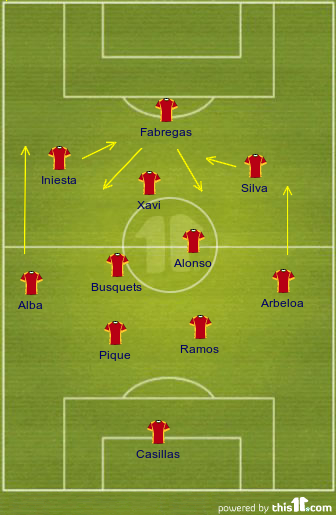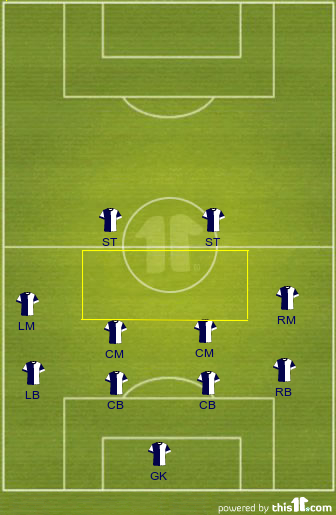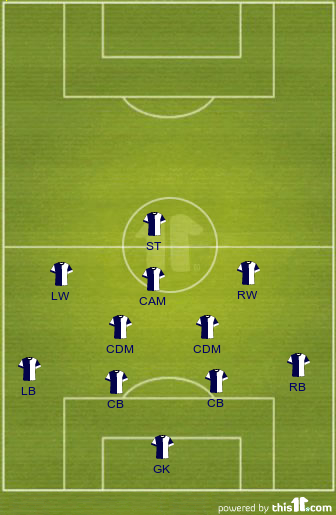So, what sets these too similar formations apart? Why is one so more effective than the other, whilst being very much alike? One of the reasons as to why the 4-2-3-1 is so widely used is simply it's versatility, you'll be able to find this formation alongside nearly every playing style, from counter-attacking to tiki-taka.
Tactical Analysis - Possession Football
 As I previously mentioned, you can easily find a 4-2-3-1 used for possession football as well as counter-attacking at the other side of the tactical spectrum. Since these are probably the two most common playing styles in modern football, these are the two I'll be analysing. World champions Spain are the best example of a side playing possession football in a 4-2-3-1, a formation they used throughout their successful Euro 2012 campaign. With wing-backs Alba and Arbeloa pushing forward (the former more than the latter), the system could be seen as a 2-4-3-1 however on paper, it was a 4-2-3-1.
As I previously mentioned, you can easily find a 4-2-3-1 used for possession football as well as counter-attacking at the other side of the tactical spectrum. Since these are probably the two most common playing styles in modern football, these are the two I'll be analysing. World champions Spain are the best example of a side playing possession football in a 4-2-3-1, a formation they used throughout their successful Euro 2012 campaign. With wing-backs Alba and Arbeloa pushing forward (the former more than the latter), the system could be seen as a 2-4-3-1 however on paper, it was a 4-2-3-1.It is easy to build attacks in a 4-2-3-1, because a holding midfielder can drop to collect the ball off of the defence without his teammates not getting isolated in the middle, something which happens in a 4-4-2. After receiiving the ball, the midfielder then has an array of passing options since the trio in the bank of 3 are far apart from eachother to have enough room so they can move and make themselves available for a pass.
On the other hand, I can't even name a side who dominated matches by keeping the ball whilst playing in a 4-4-2. This will primarily be down to the numerical disadvantage in midfield, this formation would always get outnumbered by a 4-3-3 or a 4-2-3-1, so you would just be making it more difficult for yourself if you tried playing possession football with it. Also, if one midfielder decides to drop deep and receive a pass from the defence, his teammate in the middle will get isolated since he would be outnumbered by at least two opposition midfielders.
Tactical Analysis - Counter-Attacking
The 4-2-3-1 is also used in a lot of sides who look to score on the break, Jose Mourinho's Real Madrid are one of the best teams in the world at counter-attacking, they also just happen use a 4-2-3-1. With the pace of Dí Maria and Ronaldo on the wings, the 'Special One''s side is very effective when going forward and just as good at the back.
In this video of Madrid's goals, notice how often the band of 4 that does the attacking stretches the opposition by moving wide, making the defenders move towards them which widens the channels.
One of the reasons as to why the 4-2-3-1 is a very good formation to use with the counter-attack is it's bank of 3 for both attacking and defensive reasons. Since teams defend deep when they're looking to catch their opposition out (to lure them deeper into the defending teams half, making more gaps in the defence for the counter) there is often quite a lot of space infront of the defensive line and midfield for the opposition to take advantage of if the system they're playing in doesn't field an attacking midfielder.
This is because since the defence are sitting around the edge of the box, the middle bank in midfield has to drop as well so the opposition can't put a number 10 in the hole between the two banks and create chances. Since the midfield is now deep, there is a lot of space between midfield and attack, which means that the opposition will have a lot of space and time to work with in that area. A CM can't push out of his position and stop them having time because he will leave space behind him, more valuable space to the defending team because it is closer to their goal. Because of the large amount of space that the opposition can use infront of the midfield, the 4-4-2 isn't a good formation to use on the counter-attack, their midfield can simply pass the ball around in this space until a chance opens up, and they can also intercept any counter-attacking long balls aimed towards the strikers.
The 4-2-3-1 on the other hand, doesn't give up as much space to the opposition with the bank of 3 taking up the space shown in the diagram of the 4-4-2. This means you can stay compact and sit deep, whilst not giving up space to your opponents in front of your midfield. The bank of three is also crucial in attacking on the break, since there is little space between the CB to the CDM and then also little space from the CDM to CAM, RW, and LW. The short amount of space between players allows for short and quick passes to get from defence to attack, making it easy to initiate a counter-attack. On the other hand, the large space between the midfielders and the strikers in a 4-4-2 makes the task of giving the ball to the strikers quickly difficult for the two CMs as the length of the pass is long.
If the opposition also commits midfielders forward, then the CAM will find a lot of space to receive a pass and initiate a counter-attack along with his other 3 teammates. This threat of this band of three can scare teams into not sending midfielders forward which helps the defence out greatly.
You can see these points in the video shown above, the first goal is a great example of the short passing in a counter-attack, which is made a possibility by the front four starting the move close to each other. You can also see Benzema starting wide on the right, stretching the defence by dragging the defender with the shirt number 8 (I think) out, which then gives Ronaldo the room to make a run into as Benzema then provides the assist for his Portuguese teammate. The goal starting at 0:56 also shows how the CAM has got a great amount of space to receive the pass and start the counter-attack whilst the opposition recklessely throw midfielders forward, it also clearly shows the front 4 stretching the defence (1:01 to 1:05) which results in a goal.
Statistical Analysis - Possession Football
 Against Italy, Del Bosque fielded Xavi, Silva, and Iniesta in the bank of three behind a false 9 in Fabregas. This front four was full of creativity and incredible passing ability as the Spanish completed 170 passes inside the final third, as shown by the passes chalkboard on the right.
Against Italy, Del Bosque fielded Xavi, Silva, and Iniesta in the bank of three behind a false 9 in Fabregas. This front four was full of creativity and incredible passing ability as the Spanish completed 170 passes inside the final third, as shown by the passes chalkboard on the right. As expected from this great Spain side, they dominated Italy in the final of the Euros, with 57% possession as Iniesta, Xavi, and Alonso played a major part in Spain's 4-0 victory (though the scoreline definitely flattered the winners). Because of the three attacking midfielders (Iniesta and Silva cut inside) Spain could easily pass it around in front of the deep Italy side, allowing them to be patient and wait for the space to open up, something which they did throughout the tournament, idiotically being called 'boring' because of it (since tournament football isn't about pleasing the spectators, it's about winning). The reason as to why Silva didn't have a high impact on the match is because most of the play was down Spain's left (shown in the passing chalkboard) and the City midfielder was positioned on the right.
As expected from this great Spain side, they dominated Italy in the final of the Euros, with 57% possession as Iniesta, Xavi, and Alonso played a major part in Spain's 4-0 victory (though the scoreline definitely flattered the winners). Because of the three attacking midfielders (Iniesta and Silva cut inside) Spain could easily pass it around in front of the deep Italy side, allowing them to be patient and wait for the space to open up, something which they did throughout the tournament, idiotically being called 'boring' because of it (since tournament football isn't about pleasing the spectators, it's about winning). The reason as to why Silva didn't have a high impact on the match is because most of the play was down Spain's left (shown in the passing chalkboard) and the City midfielder was positioned on the right. Statistical Analysis - Counter-Attacking
 This goal buildup is the first goal you saw (if you watched it) in that video, that beautiful counter-attack initiated from deep inside Madrid's half. You can see the short passes which were too quick for the Ajax defence, the throughball to Benzema and his cut back which gave Ronaldo an easy finish.
This goal buildup is the first goal you saw (if you watched it) in that video, that beautiful counter-attack initiated from deep inside Madrid's half. You can see the short passes which were too quick for the Ajax defence, the throughball to Benzema and his cut back which gave Ronaldo an easy finish.Those quick passes between the front four are clearly shown in the diagram - something you wouldn't see in a 4-4-2 as there isn't a linking player between defending and attack, something Mourinho has in Ozil, Alonso and now Modric.
With the pace of Tosic, Dzagoev, Doumbia, and (at the time) Vagner Love, CSKA Moscow were a threatening team on the counter-attack utilising that pace up front. However with the top two being Doumbia and Vagner Love the Russian club played a 4-4-2, which as I have said numerous times before is a poor formation for nearly all playing styles, one of them being the counter-attack.
Without a linking player in the hole, CSKA had to resort to playing a lot of long balls towards their forwards, and they ended up in this match with just 43% possession whilst completing a poor 74% of their total passes despite winning the match 3-0 and creating 9 chances throughout the match, 5 of them however being made by Dzagoev, one of Moscow's best and Russia's most promising players.
Thanks for reading guys, if I missed anything out be sure to tell me in the comments below - you don't need an account to do so! If you liked this article, you can follow me on Twitter!



No comments:
Post a Comment